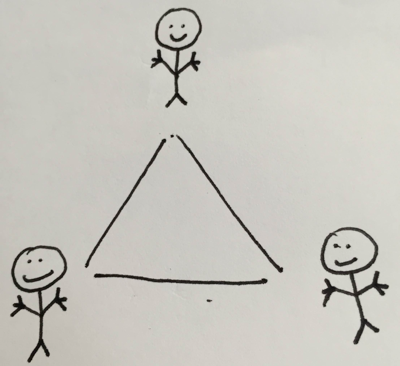This is a guest post that was originally published by Madhu Punjabi on Medium.
A mathematical insight into how products get shipped.

I love the white board. I mean, I really love the white board. As a Product Manager, I love the part of my job that allows me to dream of a better future (with our product in it, of course) and then watch it all come true.
I always thought that fast growth would mean faster product development. I’ve worked at Google, TellApart, Pinterest, and even did a short stint at Amazon. For the most part, I’ve watched companies at least double in size. You would think that fast growth means faster development. That’s not necessarily the case. In fact, by adding more people to a company, product development can actually slow down and take 2x or 3x as long to get something done. Strange, isn’t it?
Recently, I was thinking about why sometimes the path from whiteboard to execution can be so excruciating. I was surprised (and relieved) to learn that there’s actually a mathematical answer. Hopefully this tiny bit of #borrowedwisdom can help you ship faster wherever you are.
It turns out, it’s all about the handshake.
Let’s say you and I are sitting in a room. We need to make a decision. How many handshakes do we need?

One. You and I make a decision and we reach consensus.
Now, let’s say an engineering manager, a design manager, and product manager are sitting in a room trying to make a decision on what to ship. How many handshakes do you think they need to agree on a strategy?

Three. They each need to agree with each other. Design shakes hands with Product. Product shakes hands with Engineering. Engineering shakes hands with Design. At this point, consensus building looks like a triangle. Simple enough right?
Well, now let’s say, you’re part of an organization that is growing fast. People are changing, roles are changing, the team is getting bigger, excitement is building. Suddenly, you may have 10 people in the room.Guess how many handshakes you need to reach consensus?

Forty-five.
You need 45 handshakes to make a decision if 10 people are involved in the process. That’s because the problem is a geometry problem. With 10 people, we have a decagon. To solve for the number of handshakes needed, we need the sum of the sides + diagonals. We can use the following formula where n = the number of people > 3:

So if n=5,

but if n=10,

Thus, the number of handshakes is equal to 10 + 35 or 45.
In Seth Godin’s book, Linchpin, one of the reasons companies slow down is because we add more people who have decision making power. This could be why people always like to reminisce about the “good ol’ days” when the company was small. To remedy this situation, Godin offers two potential solutions:
- Limit the number of people involved in the decision
- Appoint one person to have the final say (assign ownership)
If you can’t do either of these things and you have more than three people involved in decision making, you’re in full thrash mode. You’re more likely to stagnate than you are to ship.
As a leader, it’s your job to determine when and who should be involved in the decision making process.
Frequently as a product manager, I have to make a decision about when and how to engage. The day is full of decisions. My goal is to ship a product. As they say, “it’s a marathon, not a sprint,” so I often choose when I want to engage or have a voice in the decision making process. If it’s a tricky engineering decision, we’ll make sure the engineer has the say. If it’s a decision about how our product affects users, that’s when I chime in.
It’s also my job to limit the number of handshakes needed from my peers and superiors. One product can be connected to so many parts of a larger application and it’s important to connect with other product owners to make sure your launch goes smoothly. However, it’s incredibly important to narrow down the right set of constituents in order to buy-in from the smallest group of people possible.
Whether your style is a fist bump or a good old classic handshake, remember — the less you need, the faster you ship.
About the author: This was a guest post contributed by Madhu Punjabi, Product Manager at Pinterest. This article was originally posted on Medium.
Join 30,000+ Product People and Get a Free Copy of The PM Handbook and our Weekly Product Reads Newsletter
Subscribe to get:
- A free copy of the PM Handbook (60-page handbook featuring in-depth interviews with product managers at Google, Facebook, Twitter, and more)
- Weekly Product Reads (curated newsletter of weekly top product reads)
